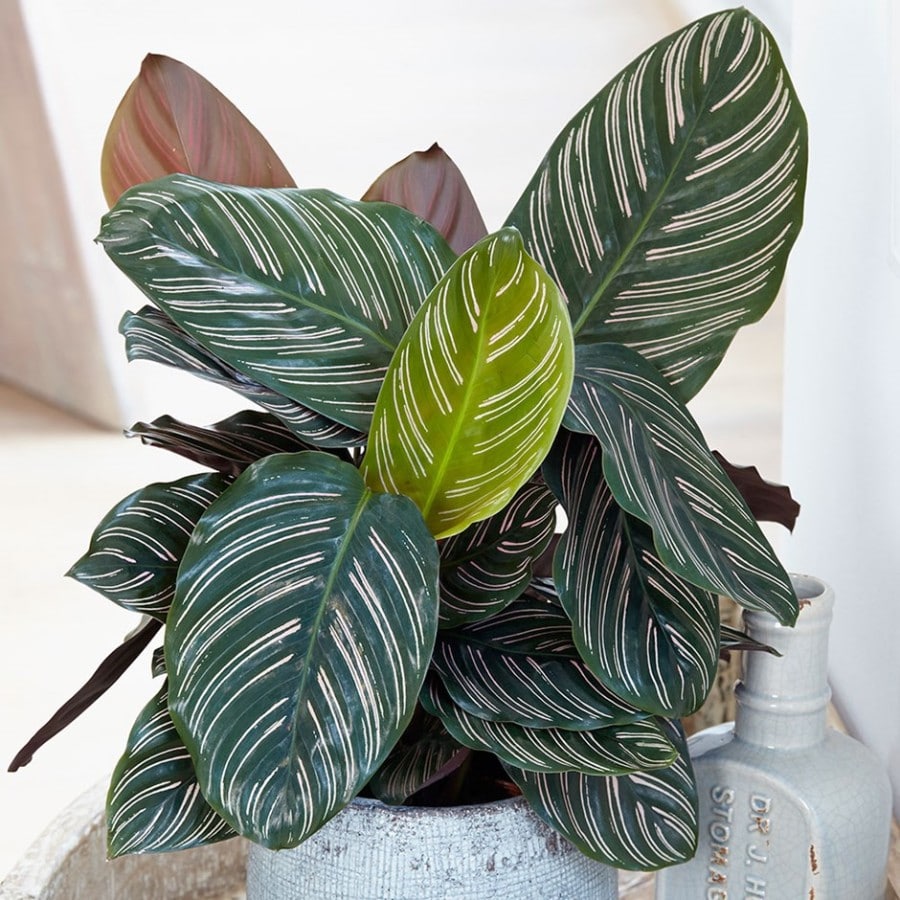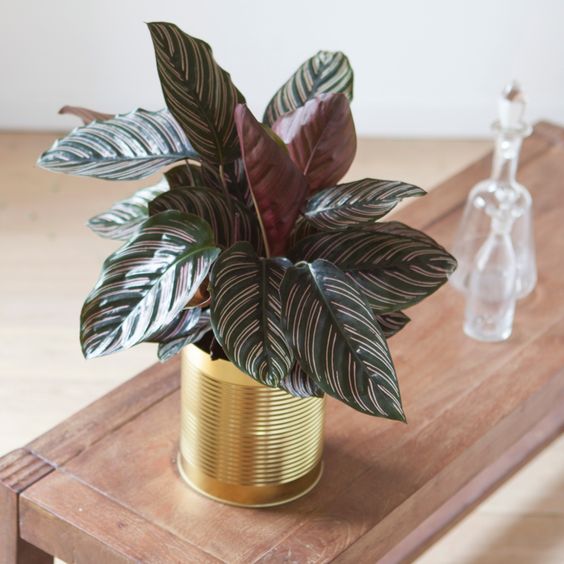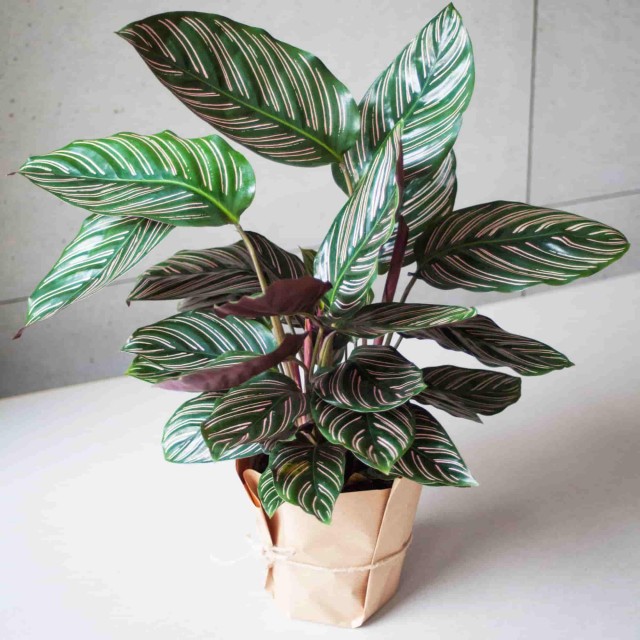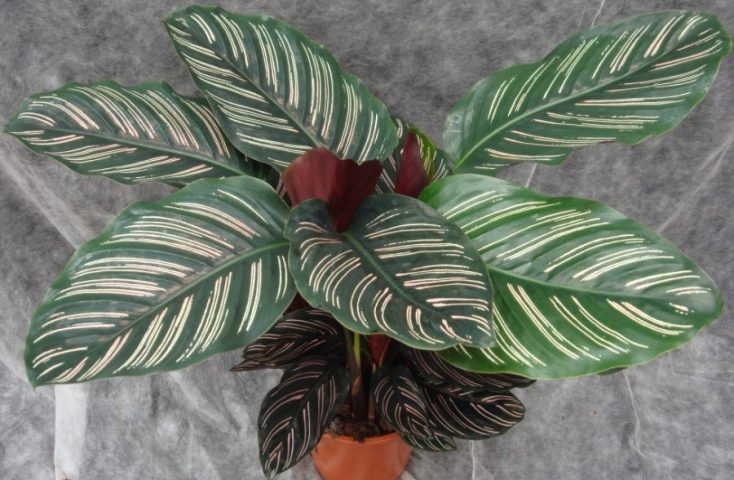Have you recently purchased (or better yet, been gifted) a
How to care for
With a little bit of practice, you’ll be able to grow a calathea ornata plant that will provide you with beauty and enjoyment for years to come. These tips will help make growing calathea ornata both easy and fun.
What Is Calathea Ornata?

A tropical plant by nature,
There are over 300 different types of Calathea plants, with multiple hybrids and commonly cultivated species around the world. These plants traditionally have gorgeous leaves with colorful patterns on the side along with red or purple underside, although this can vary depending on the specific variety and growing location. Often, calathea ornata plants that are cultivated for indoor use have green leaves with violet bottoms.
Native to Africa, the West Indies, Thailand, Central America, and South America, this plant is valued for its oval, vibrantly-colored leaves. On average, these plants grow to about two feet in height and two feet in width, making them ideal for cultivating in a container inside your home.
While these plants may seem simple in appearance, they do require a bit of care to keep looking healthy. With the proper climate and growing conditions, you can even bring your
The plant has many popular names, including the aforementioned pinstripe plant, the peacock plant, zebra plant, or cathedral plant. It has several look-alikes as well, including the prayer plant. They are often confused for each other because they both have leaves that rise and fall as the sun rises and sets – just as a person raises their hands in prayer.
However a prayer plant will have slight differences as well as different care instructions, so make sure you know exactly what kind of plant you are getting when you purchase it.
An evergreen perennial, this plant can grow easily in zones 10 and 11 but is best cultivated as an indoor plant, where you will have more control over its growing conditions. Calathea is a decorative house plant that purifies your air as it catches your eye, making a contribution not only to the visual appeal of your home, but also to your overall health and wellbeing.
Calathea plants are often called living plants because they open and close their leaves at night and in the morning. This behavior is the result of a joint between the leaf and stem that is activated by the changing lights. You may even hear your
Where To Place Calathea In Your Home

When you first bring home your calathea ornata plant, you will need to pay particular attention to its final destination. This tropical plant prefers bright, indirect light. It is rather finicky in this regard, as too little light will cause stunted growth, while too much direct sunlight can burn the plant’s delicate leaves.
In its native environment,
If you’re unsure whether your plant is being exposed to too much light, simply keep an eye on its leaves. If it starts to lose its distinctive stripes, it is receiving too much sunlight.
When selecting where you would like to place your calathea plant, make sure it has access to plenty of indirect, moderate light. A good location would be one that is bright, but shaded, particularly near an east-facing window with a curtain or shade.
How Often Should You Water Calathea Ornata?
Try to adopt a regular watering schedule for your pinstripe plant. You don’t want your soil to become completely dried out, nor do you want it to be overly saturated. The calathea ornata is not drought-tolerant, so while you want the top of the soil to dry out slightly between waterings (which helps prevent the growth of fungus and other mold issues), you don’t want it to be totally dry.
Prolonged periods of dryness can cause your plant to develop brown leaves, while overwatering will cause it to wilt and recover poorly from disease and other afflictions. Therefore, it is important that you find a watering schedule that works for you and your plant, and that once you do, you stick to it to avoid any potential problems.
If you notice that your calathea plant has developed brown, crispy leaves, it is likely due to a lack of humidity and moisture. While this can also signal a sensitivity to fluoride or other chemicals in your water, it is more likely that you are simply not watering enough. To rule out the possibility of tap water chemicals causing the browning, simply use distilled water for a few weeks. This will help you make sure this is not the case.
When you first bring your
Calathea Ornata Humidity
Like many tropical plants, this plant prefers a spot with plenty of humidity. While misting the leaves of the plant twice a week with room temperature water can help maintain adequate moisture levels, you might also consider placing this plant in a room that is naturally more humid. For best results, place your calathea ornata in the kitchen or bathroom, where it will have plenty of access to humid conditions without requiring you to keep track of it.
If this is not an option, you can also place a humidifier near the plant. A humidifier will help draw moisture to your plant and keep it there, even if you have a heat register or other drying source nearby. Another option is to place the plant on a tray covered with a layer of pebbles. Add water to the pebbles periodically, which will maintain humidity around the plant’s roots without causing them to rot. While you can back off on the watering a bit during the colder months, you must be vigilant about providing enough humidity to combat the overly dry air.
Calathea Ornata Temperature Requirements
Again, location plays a huge role in helping your
Remember that all houseplants, but particularly tropical ones, are susceptible to problems caused by cold drafts or other sudden swings in temperature. These can be difficult to avoid if you are placing your plant above a heat register or near a window, where drafts are more common, so watch your plant carefully for any signs of change, and move it to a new location as needed.
Fertilizing Calathea Ornata
Calathea plants are relatively low-maintenance in terms of fertilizing, but do benefit from a good general houseplant fertilizer every four weeks or so. This is especially important during the spring and
Don’t fertilize unless it seems as though your plant is actively growing. If it is dormant, too much fertilizer can actually burn it and prevent it from exiting its dormant stage. When fertilizing, opt for a balanced fertilizer to support growth.
Don’t assume that over-fertilizing your calathea plant will lead to increased production. If you fertilize your plant too much, the plant will become tall and lanky – not lush and verdant. Only feed the plant when it’s growing, as mentioned, and dilute liquid fertilizer to half strength (or use an organic fertilizer, like compost tea) for best results.

Diseases And Pests
Calathea
The most common pests to afflict this plant include spider mites, mealy bug, scale, and aphids, while common diseases include those related to bacterial and fungal growth (which can be prevented by paying attention to moisture and airflow).
Spider mites are one of the biggest pests you will need to watch out for in regards to your
This will knock the mites off the plant. You can also coat the leaves of your plant with neem oil, a natural pesticide that will kill the mites when they come into contact with it.
Repotting And Propagation
When potting or repotting your
A potting soil that becomes easily waterlogged will cause your plants’ roots to rot, making it less than ideal for a
You shouldn’t need to
When you’re ready to
Put the plant in a larger pot, ideally one or two years after you have first started to grow it. If you’d like, you can divide the plant if it is large enough. Make sure you mist and water the plant regularly so that it can support healthy, well-established roots.
If you want to divide the plant, separate clumps of leaves and leaf stalks when it’s repotting time. Make sure each clump of leaves has roots attached to ensure new growth. Once you’ve moved the plant, cover the plant and pot with polythene until new growth appears.
Pruning And Maintenance
You may find that your
Removing the dead growth will help maintain a good growth pattern, as well as the overall height of the plant.
It may also make sense for you to dust your calathea plant from time to time. Simply brush any dust off the leaves with a clean, damp cloth before misting the leaves to make sure all sides receive adequate humidity. When you’re done dusting and wiping down your plant, you should remove any remaining yellow leaves to provide added vigor and rejuvenation.
Why Calathea Ornata Make Great Houseplants
Calathea ornata make fantastic houseplants if you are seeking to improve the visual appearance of your home, as well as its overall appeal. Houseplants boost your health and happiness, and this gorgeous tropical plant is no exception.
For example, plants absorb carbon dioxide and release oxygen through the process of photosynthesis. When you add plants to your living space, you can increase the oxygen levels of your home and refresh the quality of your air.
Houseplants can also remove toxic volatile organic compounds (VOCs) such as benzene and formaldehyde from the air. While most climate-controlled homes trap VOCs inside, houseplants help pull these toxins out and keep your home healthier and fresher.
Having a calathea ornata plant in your home can even help sharpen your focus. Studies have shown that students and other workers have almost twice as much attentiveness when they are working in rooms containing plants. They can help lower your heart rate and blood pressure, reduce feelings of fatigue, and even reduce your likelihood of colds, dry skin, sore throat, and cough.
This plant can even help lower your stress and anxiety levels. In a recent study in the Netherlands, researchers found that hospital patients with houseplants like calathea ornata in their rooms exhibited lower stress levels than patients without houseplants. With all of these benefits of keeping a calathea ornata plant inside your home, why wouldn’t you want to grow one?
Troubleshooting Issues With Your Calathea Ornata Plant
Why Are The Leaves On My Calathea Turning Yellow?
Yellowing of the lower leaves is a normal process and as long as the new growth is vibrant and healthy, you should have no concerns. If the leaf yellowing is widespread, it may be due to a range of causes such as overwatering, excessive sunlight and pest infestation.
Calathea leaves can also be sensitive to hard, chlorinated or fluoridated water. Other stress to the plant such as low humidity or low or high temperatures can also cause yellowing of leaves and leaf drop.
Is Calathea Ornata Poisonous To Humans And Pets?
Calathea plants are not poisonous to humans and pets, and are a perfectly safe alternative to other houseplants, like aloe vera or poinsettias, which can be toxic to people and animals if ingested.

